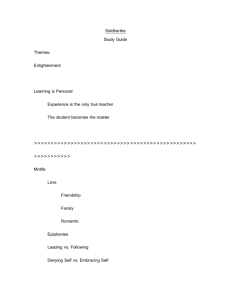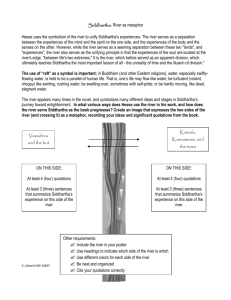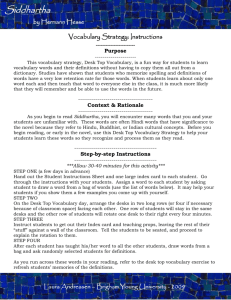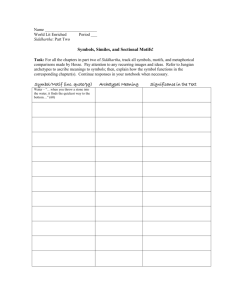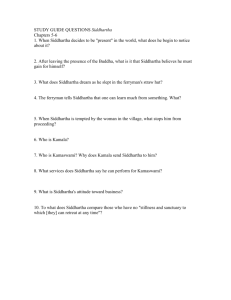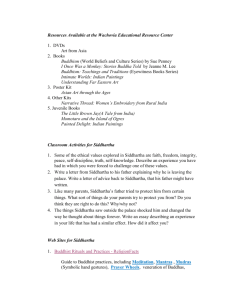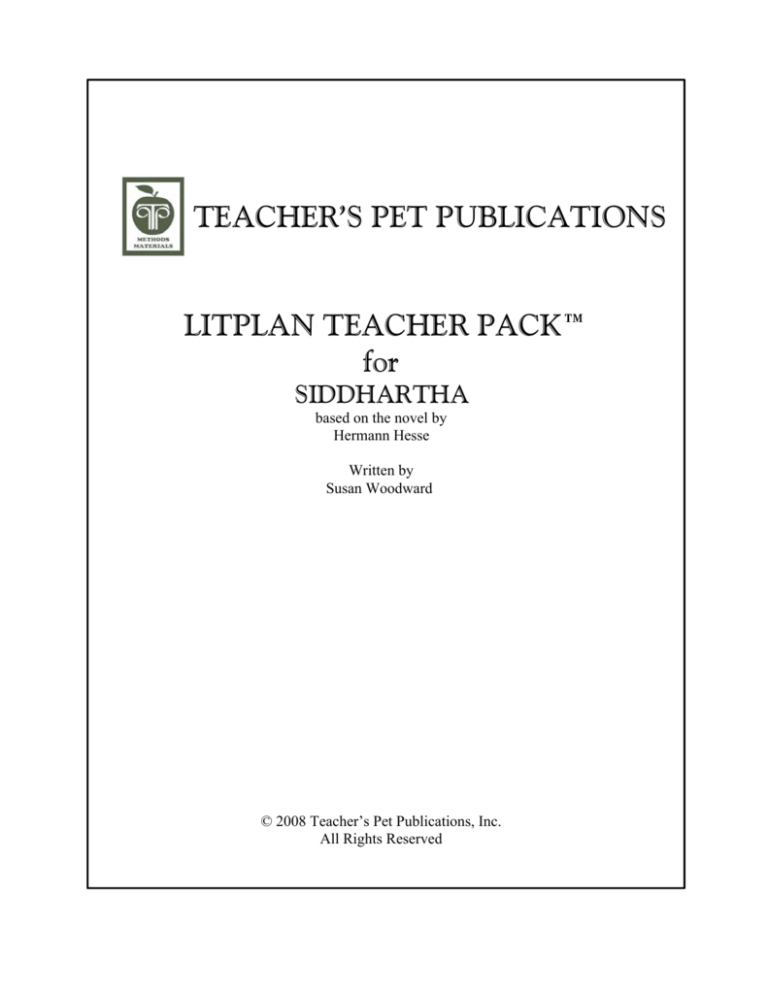
TEACHER’S PET PUBLICATIONS
LITPLAN TEACHER PACK™
for
SIDDHARTHA
based on the novel by
Hermann Hesse
Written by
Susan Woodward
© 2008 Teacher’s Pet Publications, Inc.
All Rights Reserved
Copyright Teacher's Pet Publications 2008
Only the student materials in this unit plan (such as worksheets,
study questions, and tests) may be reproduced multiple times
for use in the purchaser's classroom.
For any additional copyright questions,
contact Teacher's Pet Publications.
www.tpet.com
2 Copyright 2008 Teacher's Pet Publications, Inc.
TABLE OF CONTENTS
Siddhartha
Introduction
5
Unit Objectives
7
Reading Assignment Sheet
8
Unit Outline
9
Study Questions (Short Answer)
13
Quiz/Study Questions (Multiple Choice)
20
Pre-reading Vocabulary Worksheets
35
Lesson One (Introductory Lesson)
51
Oral Reading Evaluation Form
71
Writing Assignment #1
57
Writing Evaluation Form
111
Non-fiction Assignment Sheet
69
Writing Assignment #2
98
Writing Assignment #3
107
Extra Writing Assignments/Discussion ?s
102
Vocabulary Review Activities
88
Unit Review Activities
112
Unit Tests
119
Unit Resource Materials
165
Vocabulary Resource Materials
183
Copyright 2008 Teacher's Pet Publications, Inc. 3
INTRODUCTION Siddhartha
This LitPlan has been designed to develop students' reading, writing, thinking, and language
skills through exercises and activities related to Siddhartha by Hermann Hesse. It includes
seventeen lessons, supported by extra resource materials.
The introductory lesson introduces students to Joseph Campbell's Hero's Journey. Following the
introductory activity, students are given a transition to explain how the activity relates to the book
they are about to read. Following the transition, students are given the materials they will be using
during the unit. At the end of the lesson, students begin the pre-reading work for the first reading
assignment.
The reading assignments are approximately thirty pages each; some are a little shorter while
others are a little longer. Students have approximately 15 minutes of pre-reading work to do prior
to each reading assignment. This pre-reading work involves reviewing the study questions for the
assignment and doing some vocabulary work for selected vocabulary words they will encounter in
their reading.
The study guide questions are fact-based questions; students can find the answers to these
questions right in the text. These questions come in two formats: short answer or multiple choice.
The best use of these materials is probably to use the short answer version of the questions as
study guides for students (since answers will be more complete), and to use the multiple choice
version for occasional quizzes.
The vocabulary work is intended to enrich students' vocabularies as well as to aid in the
students' understanding of the book. Prior to each reading assignment, students will complete a
two-part worksheet for selected vocabulary words in the upcoming reading assignment. Part I
focuses on students' use of general knowledge and contextual clues by giving the sentence in
which the word appears in the text. Students are then to write down what they think the words
mean based on the words' usage. Part II nails down the definitions of the words by giving
students dictionary definitions of the words and having students match the words to the correct
definitions based on the words' contextual usage. Students should then have an understanding of
the words when they meet them in the text.
After each reading assignment, students will go back and formulate answers for the study guide
questions. Discussion of these questions serves as a review of the most important events and
ideas presented in the reading assignments.
After students complete reading the work, there is a vocabulary review lesson which pulls
together all of the fragmented vocabulary lists for the reading assignments and gives students a
review of all of the words they have studied.
Following the vocabulary review, a lesson is devoted to the extra discussion questions/writing
assignments. These questions focus on interpretation, critical analysis, and personal response,
employing a variety of thinking skills and adding to the students' understanding of the novel.
There are three writing assignments in this unit, each with the purpose of informing, persuading,
or expressing personal opinions. Introspection journal entries will be converted into a poetic
reflection of the students' personal journies towards self-knowledge. Students will also complete
a poetry analysis and relate the poets' messages to themes in Siddhartha. In the persuasive
assignment, students will take a position on Siddhartha's decision regarding his son and defend
the position with textual support from the novel and the Four Noble Truths.
Copyright 2008 Teacher's Pet Publications, Inc. 5
There is a non-fiction reading assignment. Students must read non-fiction articles, books, etc. to
gather information about their themes in our world today.
The review lesson pulls together all of the aspects of the unit. The teacher is given four or five
choices of activities or games to use which all serve the same basic function of reviewing all of
the information presented in the unit.
The unit test comes in two formats: multiple choice or short answer. As a convenience, two
different tests for each format have been included. There is also an advanced short answer unit
test for advanced students.
There are additional support materials included with this unit. The Unit Resource Materials
section includes suggestions for an in-class library, crossword and word search puzzles related to
the novel, and extra worksheets. There is a list of bulletin board ideas which gives the teacher
suggestions for bulletin boards to go along with this unit. In addition, there is a list of extra class
activities the teacher could choose from to enhance the unit or as a substitution for an exercise the
teacher might feel is inappropriate for his/her class. Answer keys are located directly after the
reproducible student materials throughout the unit. The Vocabulary Resource Materials
section includes similar worksheets and games to reinforce the vocabulary words.
The level of this unit can be varied depending upon the criteria on which the individual
assignments are graded, the teacher's expectations of his/her students in class discussions, and the
formats chosen for the study guides, quizzes and test. If teachers have other ideas/activities they
wish to use, they can usually easily be inserted prior to the review lesson.
The student materials may be reproduced for use in the teacher's classroom without infringement
of copyrights. No other portion of this unit may be reproduced without the written consent of
Teacher's Pet Publications, Inc.
6 Copyright 2008 Teacher's Pet Publications, Inc.
UNIT OBJECTIVES Siddhartha
1. While reading Hermann Hesse's Siddhartha, students will work both independently
and in cooperative groups.
2. Students will demonstrate their understanding of the text on four levels: factual,
interpretive, critical, and personal.
3. Students will spend time in personal reflection, examining their own personal
growth and self-knowledge.
4. Students will practice reading aloud and silently to improve their skills in each area.
5. Students will answer questions to demonstrate their knowledge and understanding
of the main events and characters in Siddhartha as they relate to the author's theme
development.
6. Students will enrich their vocabularies and improve their understanding of the novel
through the vocabulary lessons prepared for use in conjunction with the novel.
7. The writing assignments are geared to several purposes:
a. To have students demonstrate their abilities to inform, persuade, express their
own personal ideas, or be creative
b. To check students' reading comprehension
c. To make students think about ideas presented in the novel
d. To encourage logical thinking
e. To provide an opportunity for students to practice good grammar and improve
their use of standard, written English
8. Students will read aloud, report, and participate in large and small group discussions
to improve their public speaking and personal interaction skills.
Copyright 2008 Teacher's Pet Publications, Inc. 7
STUDY GUIDE QUESTIONS Siddhartha
Assignment 1
Chapters 1-2
1. Who is Govinda?
2. How do the people of Siddhartha's home town feel about him?
3. What has caused Siddhartha "to feel the seeds of discontent within him"?
4. When Siddhartha first leaves home, where does he want to go to try to acquire more
knowledge?
5. Who accompanies Siddhartha on his journey to become Samana?
6. What changes that take place in Siddhartha while on the road with the Samanas?
7. What is Siddhartha's "one single goal" on his first journey?
8. With what two animals did Siddhartha associate himself through practicing "self-denial
and meditation according to the Samana rules"?
9. Identify Gotama.
10. How does Siddhartha prove that he has mastered all that the Samana could teach him?
Assignment 2
Chapters 3-4
1. What is Jetavana?
2. By what qualities do Siddhartha and Govinda recognize the Buddha?
3. Why is Siddhartha not very curious about the teachings of the Buddha?
4. What is Siddhartha's response to Govinda's question about following the Buddha?
5. What does the Buddha warn Siddhartha to be on his guard against?
6. What separates Govinda and Siddhartha?
7. What does Siddhartha realize has left him "like the old skin that a snake sheds"?
8. What realization gives Siddhartha the feeling of awakening from a long dream?
9. After Siddhartha decides not to join the Buddha's community, from whom does he
choose to learn?
10. After Siddhartha leaves Jetavana grove, where does he initially intend to go?
Assignment 3
Chapters 5-6
1. When Siddhartha decides to be "present" in the world, what does he begin to notice
about it?
2. After leaving the presence of the Buddha, what is it that Siddhartha believes he must
gain for himself?
3. What does Siddhartha's dream as he slept in the ferryman's straw hut.
4. The ferryman tells Siddhartha that one can learn much from something. What?
5. When Siddhartha is tempted by the woman in the village, what stops him from
proceeding?
6. Who is Kamala?
Copyright 2008 Teacher's Pet Publications, Inc. 13
STUDY GUIDE QUESTIONS ANSWER KEY Siddhartha
Assignment 1
Chapters 1-2
1. Who is Govinda?
Govinda is Siddhartha's friend. He is the son of a Brahmin.
2. How do the people of Siddhartha's home town feel about him?
The townspeople admire and love Siddhartha.
3. What has caused Siddhartha "to feel the seeds of discontent within him"?
Siddhartha believes that he has obtained all the knowledge that his father and teachers
can offer, but it is not enough.
4. When Siddhartha first leaves home, where does he want to go to try to acquire more
knowledge?
He wants to travel with the ascetics and become a Samana.
5. Who accompanies Siddhartha on his journey to become Samana?
Govinda accompanies Siddhartha.
6. What changes take place in Siddhartha while on the road with the Samanas?
He becomes thin from fasting, his nails grow long, he gives away his clothes, he snarls
at women, and he looks at well-dressed people with contempt.
7. What is Siddhartha's "one single goal" on his first journey?
He wishes to let the Self die.
8. With what two animals did Siddhartha associate himself through practicing "self-denial
and meditation according to the Samana rules"?
Siddhartha compares himself to the heron and the jackal.
9. Identify Gotama.
Gotama is the Illustrious One, the Buddha who has reportedly attained Nirvana and
wanders the countryside preaching. Govinda follows him, but Siddhartha chooses not
to.
10. How does Siddhartha prove that he has mastered all that the Samana could teach him?
Siddhartha hypnotizes the eldest Samana, proving that he has mastered all that the
Samana could teach him.
Assignment 2
Chapters 3-4
1. What is Jetavana?
It is the Buddha's favorite place to stay, which had been given to him by Anathapindika.
2. By what qualities do Siddhartha and Govinda recognize the Buddha?
They recognize him only by his complete peacefulness of demeanor, by the stillness of
his form, in which there was no seeking, no will, no counterfeit, no effort--only light and
peace.
3. Why is Siddhartha not very curious about the teachings of the Buddha?
He does not think the Buddha can teach him anything new.
4. What is Siddhartha's response to Govinda's question about following the Buddha?
Siddhartha blesses Govinda and wishes him well but says he will not be joining the
Buddha's company.
5. What does the Buddha warn Siddhartha to be on his guard against?
The Buddha warns Siddhartha to be on his guard against too much cleverness.
16 Copyright 2008 Teacher's Pet Publications, Inc.

